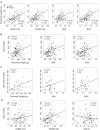Pancreatic beta cell/islet mass and body mass index
- PMID: 30668226
- PMCID: PMC6389280
- DOI: 10.1080/19382014.2018.1557486
Pancreatic beta cell/islet mass and body mass index
Abstract
Body mass index (BMI) is widely used to define obesity. In studies of pancreatic beta-cell/islet mass, BMI is also a common standard for matching control subjects in comparative studies along with age and sex, based on the existing dogma of their significant positive correlation reported in the literature. We aimed to test the feasibility of BMI and BSA to assess obesity and predict beta-cell/islet mass. We used National Health and Nutrition Examination Survey (NHANES) data that provided dual-energy Xray absorptiometry (DXA)-measured fat mass (percent body fat; %BF), BMI, and BSA for adult subjects (20-75y; 4,879 males and 4,953 females). We then analyzed 152 cases of islet isolation performed at our center for correlation between islet yields and various donor anthropometric indices. From NHANES, over 50% of male subjects and 60% of female subjects with BMI:20.1-28.1 were obese as defined by %BF, indicating a poor correlation between BMI and %BF. BSA was also a poor indicator of %BF, as broad overlap was observed in different BSA ranges. Additionally, BMI and BSA ranges markedly varied between sex and race/ethnicity groups. From islet isolation, BMI and BSA accounted for only a small proportion of variance in islet equivalent (IEQ; r2 = 0.09 and 0.11, respectively). BMI and obesity were strongly correlated in cases of high BMI subjects. However, the critical populations were non-obese subjects with BMI ranging from 20.1-28.1, in which a substantial proportion of individuals may carry excess body fat. Correlations between BMI, BSA, pancreas weight and beta-cell/islet mass were low.
Keywords: adiposity; beta cell mass; body mass index; body surface area; islets; obesity.
Figures


References
-
- Wang X, Misawa R, Zielinski MC, Cowen P, Jo J, Periwal V, Ricordi C, Khan A, Szust J, Shen J, et al. Regional differences in islet distribution in the human pancreas–preferential beta-cell loss in the head region in patients with type 2 diabetes. PLoS One. 2013;8:e67454. doi:10.1371/journal.pone.0067454. - DOI - PMC - PubMed
Publication types
MeSH terms
Grants and funding
LinkOut - more resources
Full Text Sources
Medical
Miscellaneous
